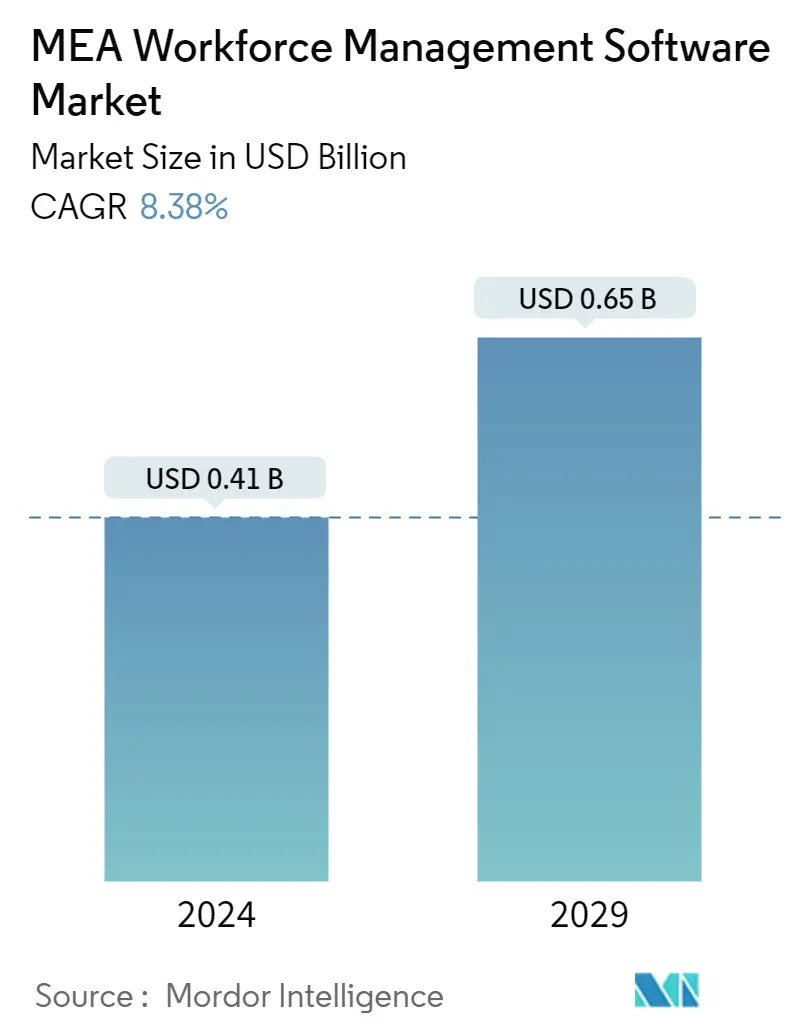Market Size of MEA Workforce Management Software Industry

| Study Period | 2019 - 2029 |
| Base Year For Estimation | 2023 |
| Market Size (2024) | USD 0.41 Billion |
| Market Size (2029) | USD 0.65 Billion |
| CAGR (2024 - 2029) | 8.38 % |
| Market Concentration | Low |
Major Players
*Disclaimer: Major Players sorted in no particular order |
Need a report that reflects how COVID-19 has impacted this market and its growth?
MEA Workforce Management Software Market Analysis
The MEA Workforce Management Software Market size is estimated at USD 0.41 billion in 2024, and is expected to reach USD 0.65 billion by 2029, growing at a CAGR of 8.38% during the forecast period (2024-2029).
- The increasing usage of advanced technology, such as artificial intelligence, drives the workforce management market. The growing need of small and medium-sized organizations for the Internet of Things and the ever-increasing popularity of remote workforce solutions will intensify the demand for workforce management. Smartphone penetration is increasing, and businesses focus more on human resource analytics, leading to more profitable growth prospects in the workforce management industry.
- Companies can utilize AI in workforce management to assess their existing employees' talent inventory and leverage historical skill data to match individuals with appropriate open positions advertised by managers while considering skills adjacency, prior experiences, and intended career paths. Workers receive better visibility into a diverse pool of projects and experiences available within their business that would otherwise be inaccessible due to the value-add of personalized recommendations that serve up appropriate opportunities. For example, Saudi Arabia will invest USD 20 billion in Artificial Intelligence by 2030. This may create an opportunity for the market players to incorporate AI in workforce management solutions.
- The increasing adoption of IoT and cloud-based solutions is reshaping the workforce management software market by enhancing data-driven decision-making, enabling remote workforce management, and providing scalability and cost-effectiveness for businesses. The workforce management software market will experience further growth and innovation as these technologies evolve and are expected to experience further growth and innovation.
- The growing adoption of analytical solutions and workforce management software by SMEs in the MEA region is driving market growth. As more businesses recognize the advantages of these technologies, the demand for workforce management software is expected to continue to rise in the coming years.
- The MEA workforce management software market may face several implementation and integration concerns hindering the market. Data security and privacy are critical concerns for organizations in the MEA region; businesses may hesitate to move their employee and operational data to cloud-based workforce management solutions due to data breaches and regulatory compliance concerns.
- Over the last decade, remote employment has become increasingly popular. Nevertheless, COVID-19 significantly accelerated this trend in a short time, compelling businesses of all sizes to rapidly adopt the self-isolation measures that governments in the region were advising. Because it can assist in effectively handling the remote workforce and the pandemic's requirement for more people to work remotely, remote workforce management software has emerged as a crucial tool for businesses.
- According to the IMF, the UAE economy recovered swiftly from the effects of COVID-19, with strong near-term economic growth supported by a pickup in domestic activity and high surpluses in the fiscal and external balances. According to the most recent IMF estimate, the UAE GDP growth is predicted to increase to above 6% in the current year from 3.8% last year. Fiscal surpluses have grown despite rising oil costs and a gradual reduction in fiscal support for households and businesses due to the COVID crisis.
